A Semantic Link Network Model for Supporting Traceability of Logistics on Blockchain
Abstract
Highlights
- A semantic link network model for representing logistics transport transactions and states.
- A semantic link with state representation for supporting data security and logistics traceability.
- A location mapping mechanism for ensuring logistics traceability.
- The semantic link network model is expressive and extensible in modelling complex systems and dynamic semantics.
- The semantic link network model is capable of modelling and implementing decentralized and distributed applications.
Abstract
1. Introduction
2. Related Work
2.1. Logistics Traceability
2.2. Blockchain Technique
2.3. Implementing Logistics Traceability on Blockchain
- (1)
- Data storage
- (2)
- Implementation of logistics rules
- (3)
- Trace efficiency
- (4)
- State confirmation
3. Logistics Transport Semantic Link Network Model for Supporting Traceability
3.1. Basic Framework
3.2. Semantic Link Network Model for Logistics Transport
- V is the set of unique IDs of the nodes of the network.
- D = {d1, d2, …, dn} is the set of logistics object IDs.
- E = {vi—<l, d>→vj | vi, vj∈V, d∈D} is the set of logistics transport semantic links (links) where vi—<l, d>→vj is a semantic link from node vi to vj attached by a logistics object ID d and l is the data structure that consists of the unique ID of the link, the link type, the link state and the attached data of the logistics transport including the cost of the transport, the time constraints and other user-defined data structures for the logistics transport.
3.3. Location Representation of a Logistics Object
3.4. State Representation Model of Semantic Link
- In the state l(j) = Init, the logistics object d of l is going to move from vi to vk;
- In the state l(j) = Transporting, the logistics object d of l is being transported through l from vi to vk but the transport is still not completed;
- In the state l(j) = Succeeded, the logistics object d of l is successfully moved from vi to vk;
- In the state l(j) = Failed, a logistics object d of l failed to move from vi to vk.
- In the state l(j) = End, a logistics object d of l halts.
- l(n) = Init⇒ d(n) =vk;
- l(n) = Transporting⇒ l(n − 1) = Init | Transporting, d(n − 1) = vk | l and d(n) = l;
- l(n) = Succeeded⇒ l(n − 1) = Transporting, d(n − 1) = l and d(n) = vj;
- l(n) = End⇒ l(n − 1) = Init | Succeeded | Failed, d(n) = End, and d(n + 1) = End;
- l(n) = Failed ⇒ l(n − 1) = Init | Transporting and d(n) = vj.
3.5. Schema of Semantic Link State Transition
- Init→ Transporting | Failed | End;
- Transporting→ Transporting | Succeeded | Failed;
- Failed→ Init | End;
- Succeeded→ End.
4. Publishing and Tracing Links on Blockchain
4.1. Mapping Semantic Link to a Blockchain Transaction
4.2. Publishing States of Link on Blockchain
4.2.1. Mapping States of Semantic Link to Blockchain Transaction
- H(l, d(n)) = u if d(n) = u;
- H(l, d(n)) = u if d(n) = l;
- H(l, d(n)) = v if d(n) = v; and,
- H(l, d(n)) = H(l, d(n − 1)) if d(n) = End,
4.2.2. Publishing Multiple Blockchain Transactions for One Logistics Object
4.2.3. Procedure of Publishing a Blockchain Transaction
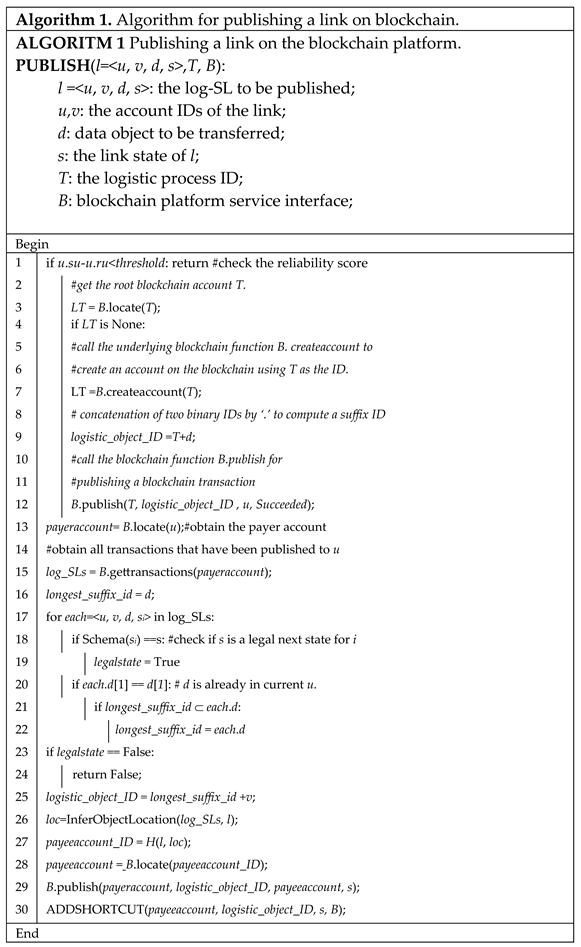 |
4.2.4. Scenario of Publishing Semantic Links on Blockchain
4.3. Traceability of Semantic Links on Blockchain
5. Reducing the Average Accesses to Account
5.1. Improving Efficiency of Path Tracing by Adding Shortcut Links
 |
5.2. Analysis of Performance of Tracing Path Along Shortcut Links
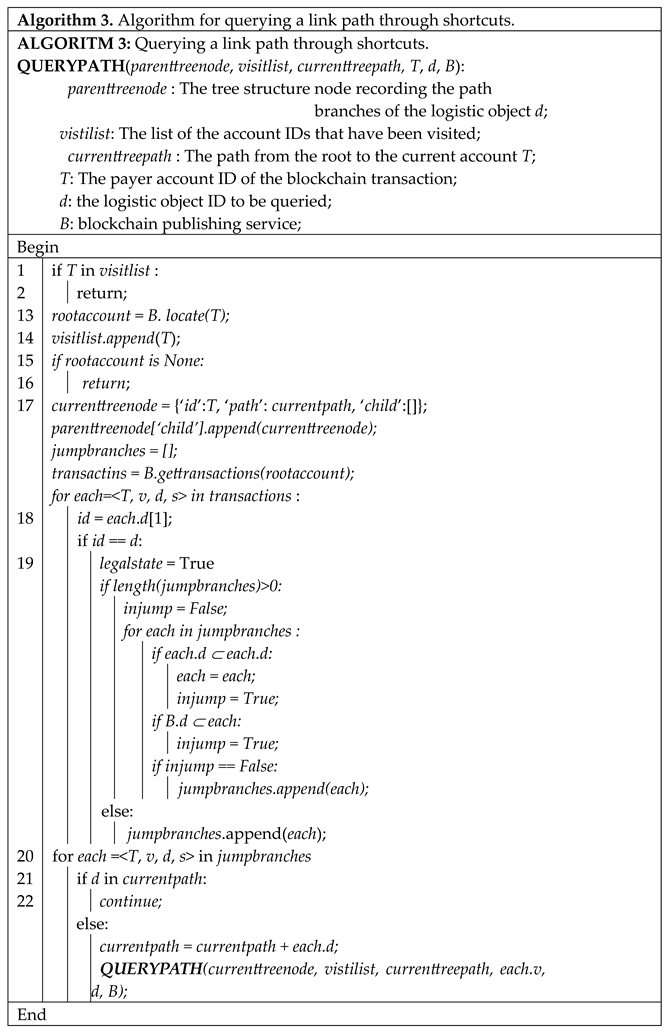 |
5.3. Penalty-Reward for Speeding up Confirmation of Link States
- (1)
- The trustiness transactions are issued between su and sv, which are used to send confirmation requests and confirmation responses for each published link t (two green arrows in Figure 7). The trustiness score is added by St when there is a new link t to be confirmed. A trustiness transaction will transfer St from su to sv. Thus, the trustiness transaction can be executed only once for one link. When node v confirms the link state, the trustiness score St is sent back to su in another trustiness transaction, and a reward score αt is added to both trustiness accounts of su and sv.
- (2)
- If node v has a conflict on the confirmation, it needs to start an argument to respond to node u. In this case, it will not use the trustiness transaction. Instead, node v uses the account rv to make an argument response transaction to ru with score St (gray arrow in Figure 7). However, the response account rv does not have initial scores, which need to borrow scores from its own trustiness account sv in a borrow trustiness transaction (dark arrows in Figure 7). Then, the score is sent to the responsibility account in an argument response transaction. When node u receives the transaction scores in its ru, it knows that there is a conflict on confirmation. Node u needs to check the transport with node v so that they can reach a consensus on the state of the link.
- (3)
- If they reach a consensus, node u uses the confirm response transaction to send score St back to the trustiness account sv of node v. Then, node v sends St back to node u through a trustiness transaction. In this case, the confirmation completes.
- (4)
- If they need further arguments, response transactions are used to send scores from their own responsibility account to counterpart’s responsibility account, until one sends the score St back to the trustiness account, which indicates that they reach consensus.
6. Experimental Evaluation of Path State Query
- (1)
- shortcut-head: only the head node of the logistics path needs to add shortcut links along the path. The reset nodes do not add shortcut links.
- (2)
- shortcut-eachone: each node only adds one shortcut link. That is, when the first shortcut link is added for a node, the process of adding shortcut links is stopped for the node.
- (3)
- shortcut-all: Each node performs the whole process of adding shortcut links.
7. Conclusions
Author Contributions
Funding
Data Availability Statement
Conflicts of Interest
References
- Allam, Z.; Newman, P. Redefining the Smart City: Culture, Metabolism and Governance. Smart Cities 2018, 1, 4–25. [Google Scholar] [CrossRef]
- Amiri, M.J.; Agrawal, D.; Abbadi, A.E. Permissioned Blockchains: Properties, Techniques and Applications. In Proceedings of the 2021 International Conference on Management of Data, Virtual, 20–25 June 2021. [Google Scholar]
- McConaghy, T.R.M.; Müller, A.; De Jonghe, D.; McMullen, G.; Henderson, R.; Bellemare, S. BigchainDB: A Scalable Blockchain Database. 2016. Available online: https://git.berlin/bigchaindb/site/raw/commit/b2d98401b65175f0fe0c169932ddca0b98a456a6/_src/whitepaper/bigchaindb-whitepaper.pdf (accessed on 20 April 2025).
- Treiblmaier, H.; Rejeb, A.; Strebinger, A. Blockchain as a Driver for Smart City Development: Application Fields and a Comprehensive Research Agenda. Smart Cities 2020, 3, 853–872. [Google Scholar] [CrossRef]
- Choi, T.-M.; Siqin, T. Blockchain in logistics and production from Blockchain 1.0 to Blockchain 5.0: An intra-inter-organizational framework. Transp. Res. Part E Logist. Transp. Rev. 2022, 160, 102653. [Google Scholar] [CrossRef]
- Politou, E.; Casino, F.; Alepis, E.; Patsakis, C. Blockchain Mutability: Challenges and Proposed Solutions. IEEE Trans. Emerg. Top. Comput. 2021, 9, 1972–1986. [Google Scholar] [CrossRef]
- Guo, L.; Wang, Q.; Yau, W.-C. Online/Offline Rewritable Blockchain with Auditable Outsourced Computation. IEEE Trans. Cloud Comput. 2023, 11, 499–514. [Google Scholar] [CrossRef]
- López-Pintado, O.; Dumas, M.; García-Bañuelos, L.; Weber, I. Interpreted Execution of Business Process Models on Blockchain. In Proceedings of the 2019 IEEE 23rd International Enterprise Distributed Object Computing Conference (EDOC), Paris, France, 28–31 October 2019. [Google Scholar]
- Zhuge, H. Communities and Emerging Semantics in Semantic Link Network: Discovery and Learning. IEEE Trans. Knowl. Data Eng. 2009, 21, 785–799. [Google Scholar] [CrossRef]
- Zhao, K.; Scheibe, K.; Blackhurst, J.; Kumar, A. Supply Chain Network Robustness Against Disruptions: Topological Analysis, Measurement, and Optimization. IEEE Trans. Eng. Manag. 2019, 66, 127–139. [Google Scholar] [CrossRef]
- Appel, S.; Kleber, P.; Frischbier, S.; Freudenreich, T.; Buchmann, A. Modeling and execution of event stream processing in business processes. Inf. Syst. 2014, 46, 140–156. [Google Scholar] [CrossRef]
- Combi, C.; Oliboni, B.; Zerbato, F. Integrated Exploration of Data-Intensive Business Processes. IEEE Trans. Serv. Comput. 2023, 16, 383–397. [Google Scholar] [CrossRef]
- Biswas, D.; Jalali, H.; Ansaripoor, A.H.; De Giovanni, P. Traceability vs. sustainability in supply chains: The implications of blockchain. Eur. J. Oper. Res. 2022, 305, 128–147. [Google Scholar] [CrossRef]
- Menon, S.; Jain, K. Blockchain Technology for Transparency in Agri-Food Supply Chain: Use Cases, Limitations, and Future Directions. IEEE Trans. Eng. Manag. 2024, 71, 106–120. [Google Scholar] [CrossRef]
- Nakamoto, S. Bitcoin: A Peer-to-Peer Electronic Cash System. 2008. Available online: https://bitcoin.org/bitcoin.pdf (accessed on 20 April 2025).
- Munasinghe, U.J.; Halgamuge, M.N. Supply chain traceability and counterfeit detection of COVID-19 vaccines using novel blockchain-based Vacledger system. Expert Syst. Appl. 2023, 228, 120293. [Google Scholar] [CrossRef] [PubMed]
- Dinh, T.T.A.; Liu, R.; Zhang, M.; Chen, G.; Ooi, B.C.; Wang, J. Untangling Blockchain: A Data Processing View of Blockchain Systems. IEEE Trans. Knowl. Data Eng. 2018, 30, 1366–1385. [Google Scholar] [CrossRef]
- Cui, J.; Ouyang, F.; Ying, Z.; Wei, L.; Zhong, H. Secure and Efficient Data Sharing Among Vehicles Based on Consortium Blockchain. IEEE Trans. Intell. Transp. Syst. 2022, 23, 8857–8867. [Google Scholar] [CrossRef]
- Li, X.; Jiang, P.; Chen, T.; Luo, X.; Wen, Q. A survey on the security of blockchain systems. Futur. Gener. Comput. Syst. 2020, 107, 841–853. [Google Scholar] [CrossRef]
- Salman, T.; Zolanvari, M.; Erbad, A.; Jain, R.; Samaka, M. Security Services Using Blockchains: A State of the Art Survey. IEEE Commun. Surv. Tutorials 2019, 21, 858–880. [Google Scholar] [CrossRef]
- Amiri, M.J.; Agrawal, D.; El Abbadi, A. SharPer: Sharding Permissioned Blockchains Over Network Clusters. In Proceedings of the 2021 International Conference on Management of Data, Virtual, 20–25 June 2021. [Google Scholar] [CrossRef]
- Kalajdjieski, J.; Raikwar, M.; Arsov, N.; Velinov, G.; Gligoroski, D. Databases fit for blockchain technology: A complete overview. Blockchain: Res. Appl. 2022, 4, 100116. [Google Scholar] [CrossRef]
- Wang, Z.; Wang, T.; Hu, H.; Gong, J.; Ren, X.; Xiao, Q. Blockchain-based framework for improving supply chain traceability and information sharing in precast construction. Autom. Constr. 2020, 111, 103063. [Google Scholar] [CrossRef]
- Liu, Z.; Li, Z. A blockchain-based framework of cross-border e-commerce supply chain. Int. J. Inf. Manag. 2020, 52, 102059. [Google Scholar] [CrossRef]
- Hader, M.; Tchoffa, D.; El Mhamedi, A.; Ghodous, P.; Dolgui, A.; Abouabdellah, A. Applying integrated Blockchain and Big Data technologies to improve supply chain traceability and information sharing in the textile sector. J. Ind. Inf. Integr. 2022, 28, 100345. [Google Scholar] [CrossRef]
- Zarrin, J.; Phang, H.W.; Saheer, L.B.; Zarrin, B. Blockchain for decentralization of internet: Prospects, trends, and challenges. Clust. Comput. 2021, 24, 2841–2866. [Google Scholar] [CrossRef]
- Ng, W. Developing RFID database models for analysing moving tags in supply chain management. In Proceedings of the 30th International Conference on Conceptual Modeling (ER’11), Brussels, Belgium, 31 October–3 November 2011; Springer: Berlin/Heidelberg, Germany, 2011; pp. 204–218. [Google Scholar]
- Lu, Q.; Xu, X. Adaptable Blockchain-Based Systems: A Case Study for Product Traceability. IEEE Softw. 2017, 34, 21–27. [Google Scholar] [CrossRef]
- López-Pintado, O.; García-Bañuelos, L.; Dumas, M.; Weber, I. Caterpillar: A Blockchain-Based Busi-ness Process Management System. In Proceedings of the International Conference on Business Process Management, Barcelona, Spain, 10–15 September 2017. [Google Scholar]
- Zhu, P.; Hu, J.; Li, X.; Zhu, Q. Using Blockchain Technology to Enhance the Traceability of Original Achievements. IEEE Trans. Eng. Manag. 2021, 70, 1693–1707. [Google Scholar] [CrossRef]
- Zhuge, H. “Semantic Link Network” in The Knowledge Grid: Toward Cyber-Physical Society; World Scientific Publishing Co.: Singapore, 2012. [Google Scholar]
- Zhuge, H. Cyber-Physical-Social Semantic Link Network. In Cyber-Physical-Social Intelligence: On Human-Machine-Nature Symbiosis; Springer: Singapore, 2020; pp. 55–141. [Google Scholar]
- Zhuge, H. Multi-Dimensional Summarization in Cyber-Physical Society; Elsevier: Amsterdam, The Netherlands, 2016. [Google Scholar]
- Ikkai, Y.; Maruta, T.; Komoda, N.; Goossenaerts, J. A Graph-Base Supply Chain Simulation Language and Tool with Multi-Functional Modeling. IFAC Proc. Vol. 2000, 33, 935–940. [Google Scholar] [CrossRef]
- Wu, H.Y.; Yang, X.; Yue, C.; Paik, H.-Y.; Kanhere, S.S. Chain or DAG? Underlying data structures, architectures, topologies and consensus in distributed ledger technology: A review, taxonomy and research issues. J. Syst. Arch. 2022, 131, 102720. [Google Scholar] [CrossRef]
- Rosenfeld, A.; Goldman, C.V.; Kaminka, G.A.; Kraus, S. PHIRST: A distributed architecture for P2P information retrieval. Inf. Syst. 2009, 34, 290–303. [Google Scholar] [CrossRef]
- Wu, H.; Jiang, S.; Cao, J. High-Efficiency Blockchain-Based Supply Chain Traceability. IEEE Trans. Intell. Transp. Syst. 2023, 24, 3748–3758. [Google Scholar] [CrossRef]
- Zhuge, H.; Chen, X.; Sun, X.; Yao, E. HRing: A Structured P2P Overlay Based on Harmonic Series. IEEE Trans. Parallel Distrib. Syst. 2008, 19, 145–158. [Google Scholar] [CrossRef]
- Owe, O.; Fazeldehkordi, E. A lightweight approach to smart contracts supporting safety, security, and privacy. J. Log. Algebraic Methods Program. 2022, 127, 100772. [Google Scholar] [CrossRef]
- Song, Q.; Chen, Y.; Zhong, Y.; Lan, K.; Fong, S.; Tang, R. A Supply-chain System Framework Based on Internet of Things Using Blockchain Technology. ACM Trans. Internet Technol. 2021, 21, 1–24. [Google Scholar] [CrossRef]
- Li, C.; Zhang, J.; Yang, X.; Youlong, L. Lightweight blockchain consensus mechanism and storage optimization for resource-constrained IoT devices. Inf. Process. Manag. 2021, 58, 102602. [Google Scholar] [CrossRef]
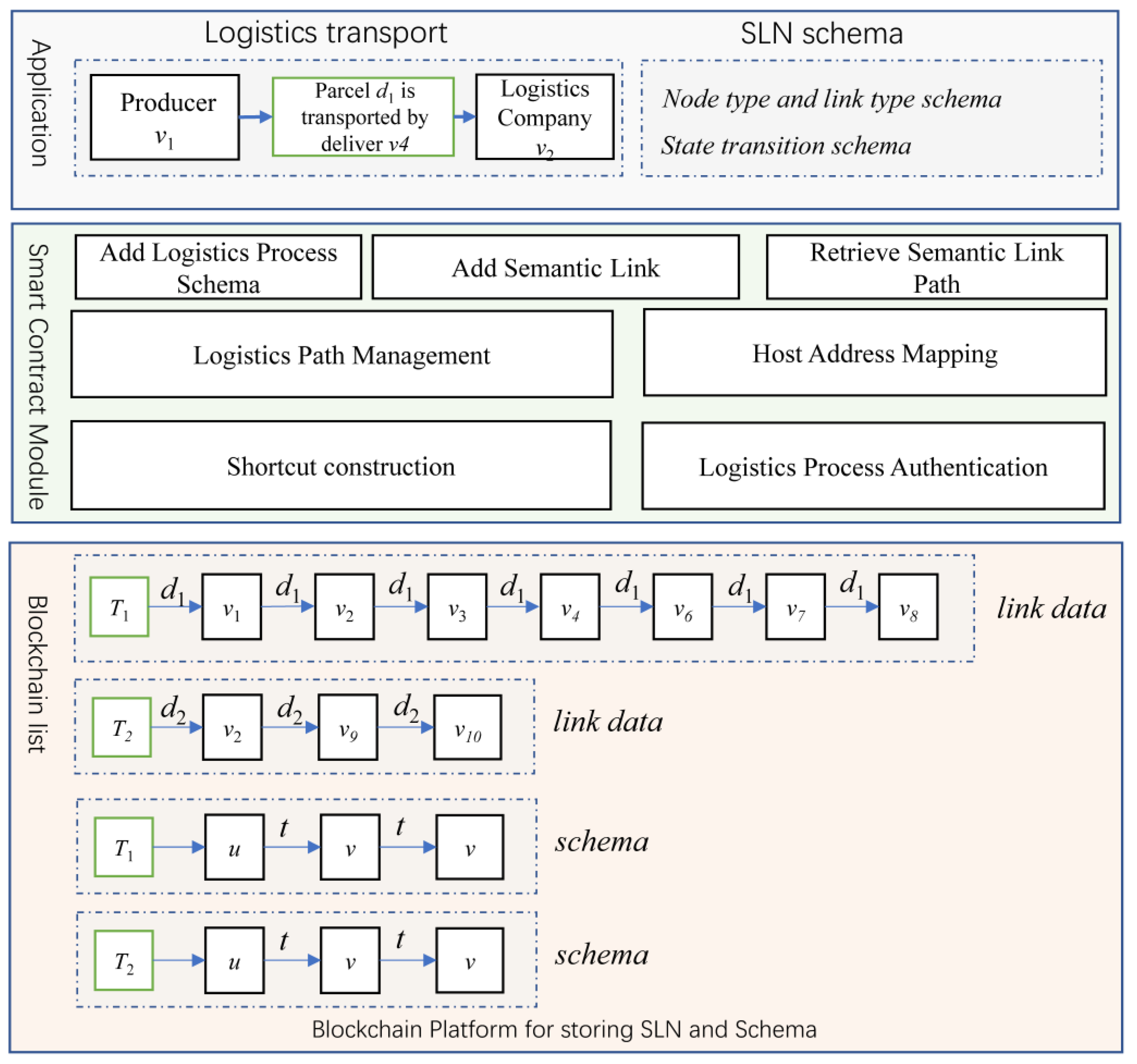
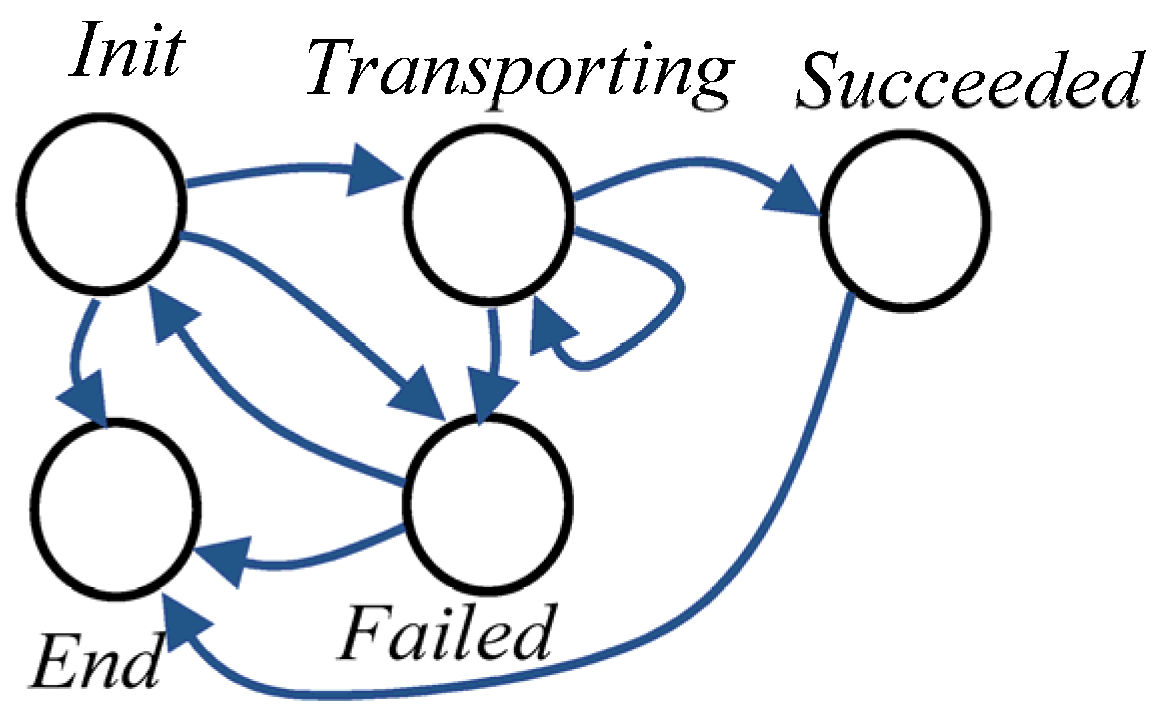
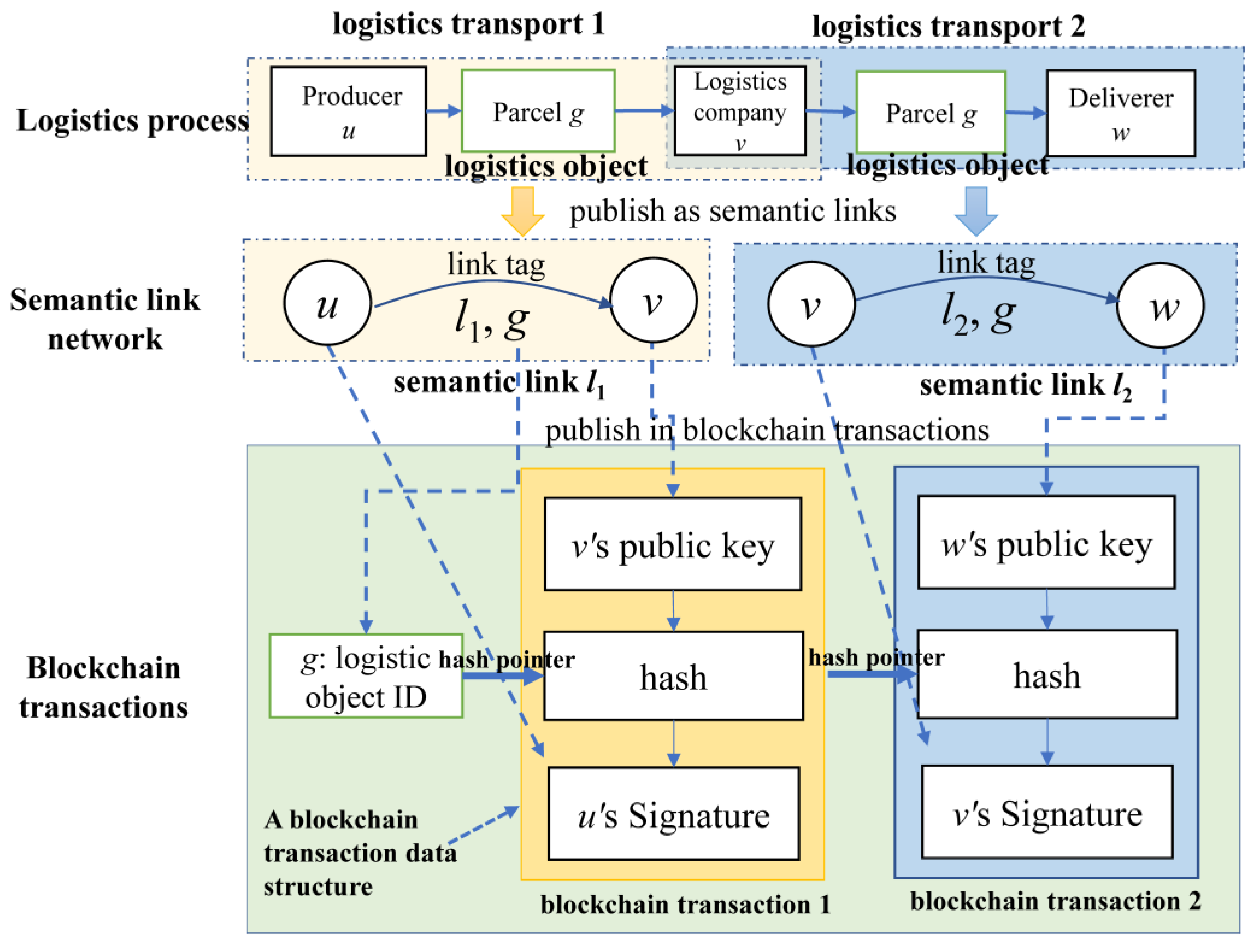
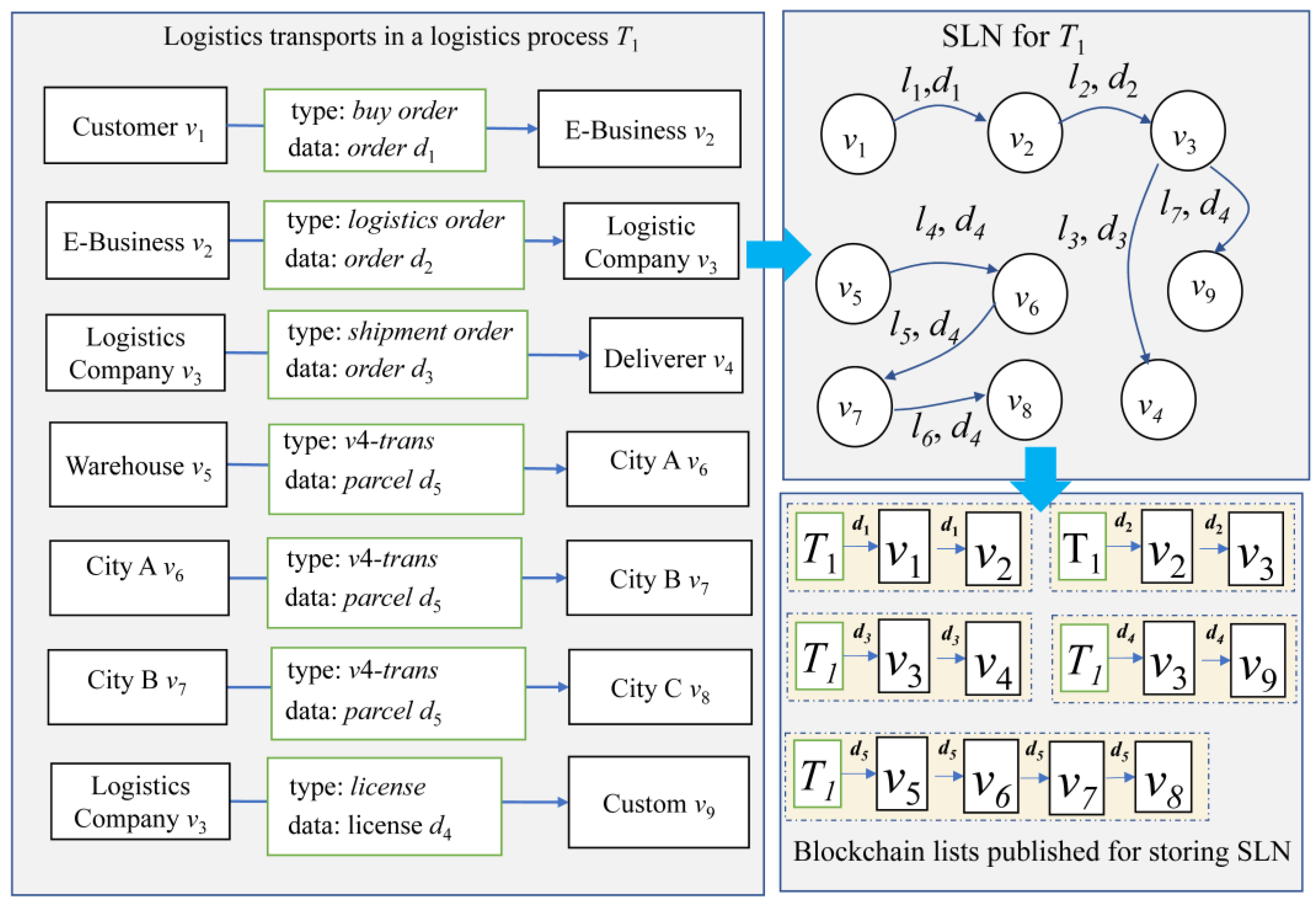
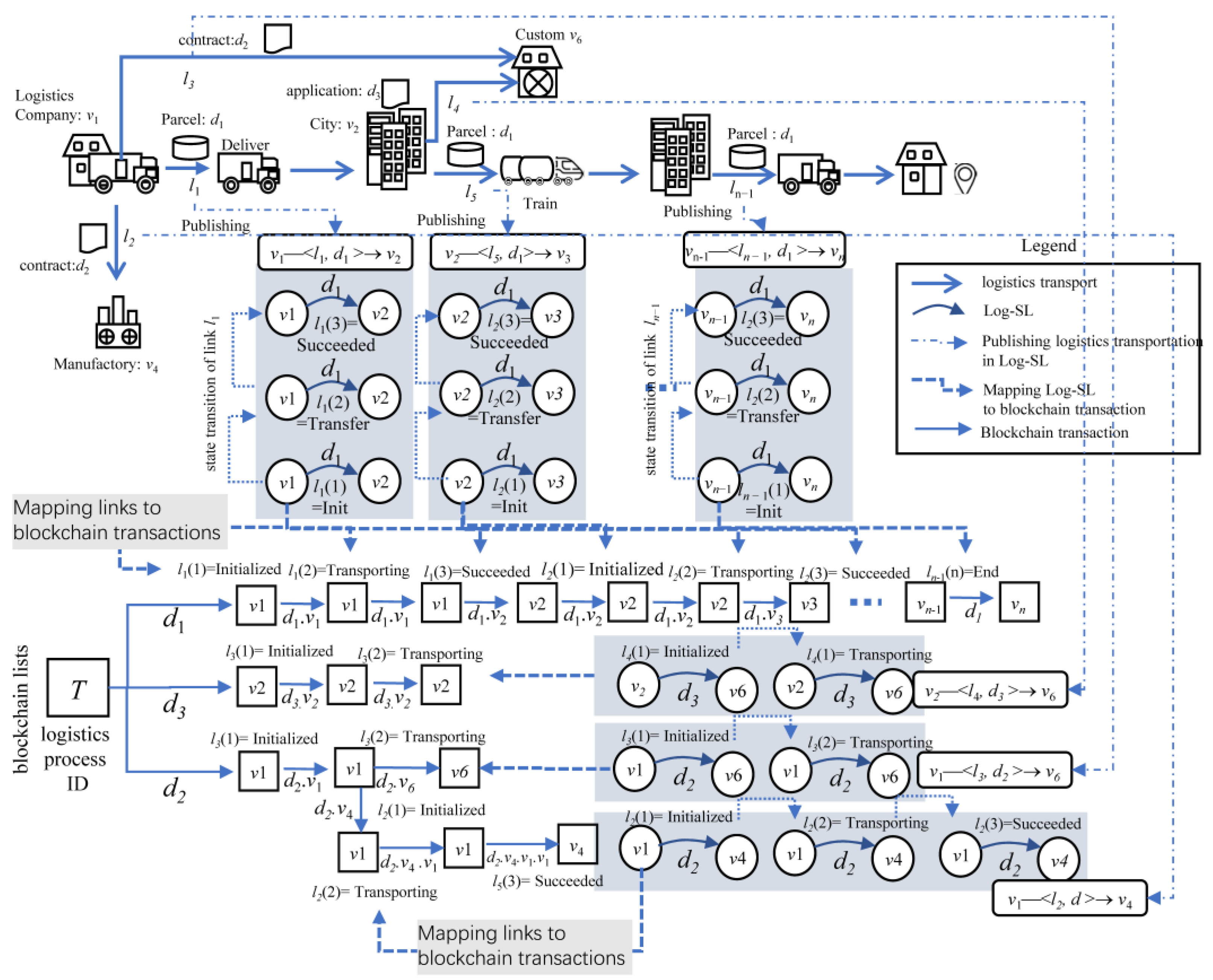
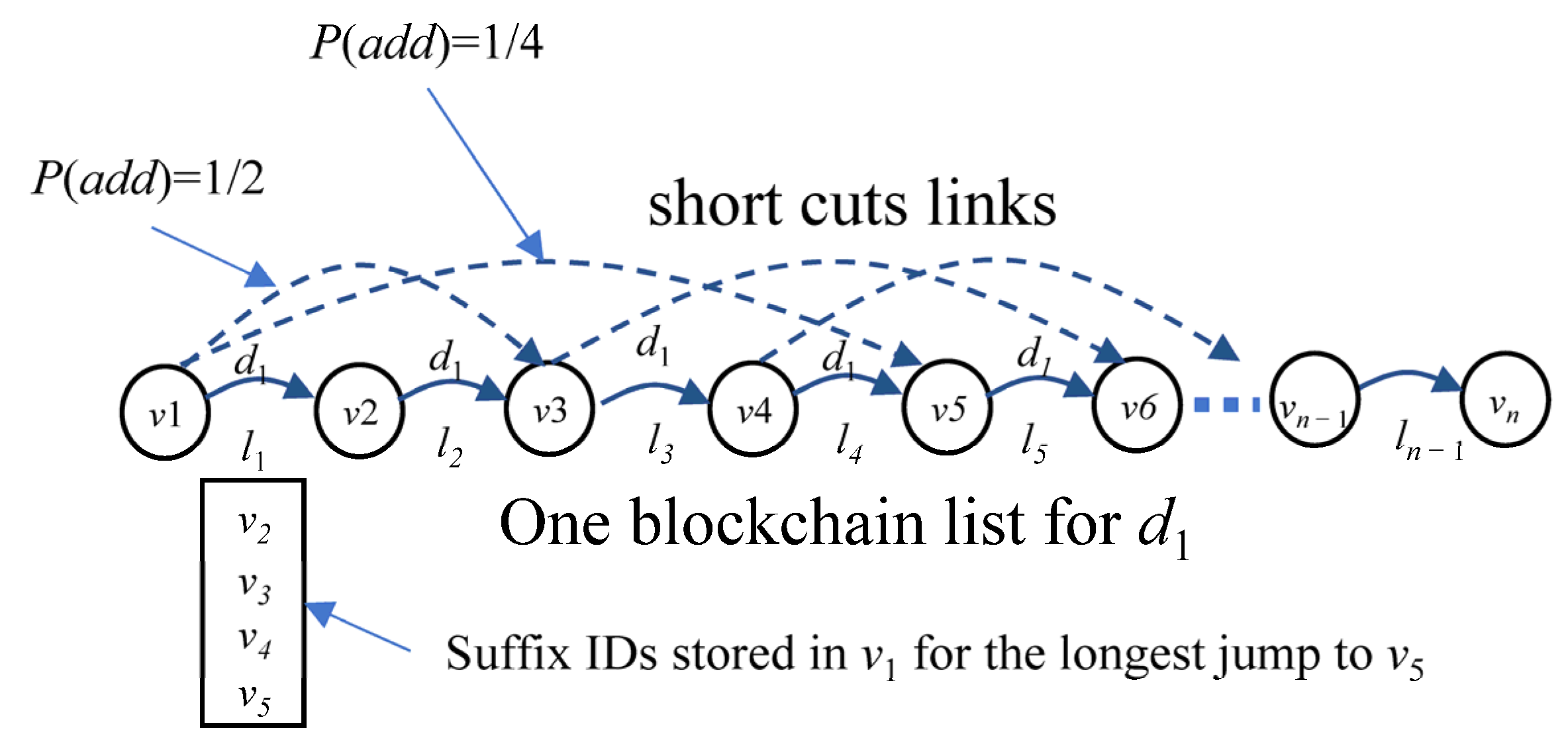
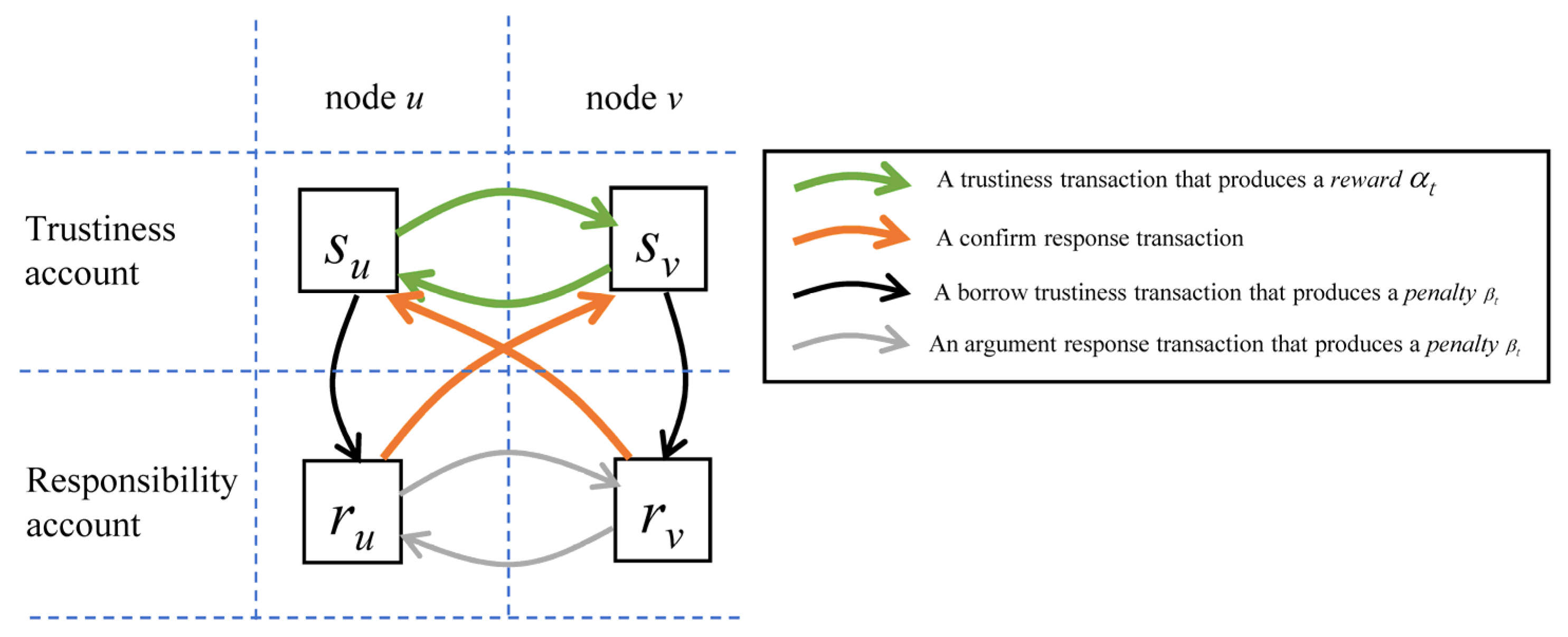
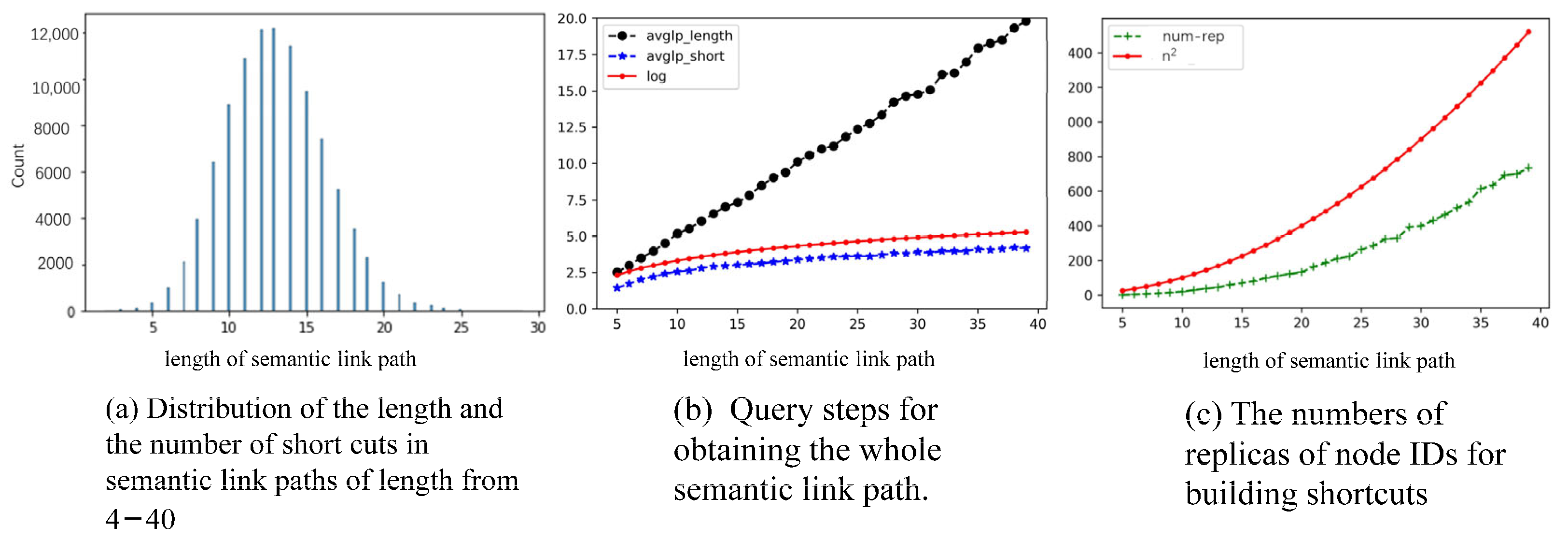

| Functions Provided by the Blockchain Platform Service Infterface B | Description |
|---|---|
| account = B.locate (ID) | Locate the account by the input argument ID on the blockchain and obtain the access authorization to publish a blockchain transaction from the obtained account. |
| account = B.createaccount (ID) | Create a new account on the blockchain using the input argument ID as the account ID. |
| B.publish (payeraccount, d, payeeaccount, s) | Publish a blockchain transaction from payeraccount to payeeaccount with d being the logistic object ID and s being the state of link. |
| transactions = B.gettransactions (payeraccount) | Obtain the blockchain transactions published by payeraccount. |
Disclaimer/Publisher’s Note: The statements, opinions and data contained in all publications are solely those of the individual author(s) and contributor(s) and not of MDPI and/or the editor(s). MDPI and/or the editor(s) disclaim responsibility for any injury to people or property resulting from any ideas, methods, instructions or products referred to in the content. |
© 2025 by the authors. Licensee MDPI, Basel, Switzerland. This article is an open access article distributed under the terms and conditions of the Creative Commons Attribution (CC BY) license (https://creativecommons.org/licenses/by/4.0/).
Share and Cite
Sun, X.; Zhuge, S.; Zhuge, H. A Semantic Link Network Model for Supporting Traceability of Logistics on Blockchain. Smart Cities 2025, 8, 115. https://doi.org/10.3390/smartcities8040115
Sun X, Zhuge S, Zhuge H. A Semantic Link Network Model for Supporting Traceability of Logistics on Blockchain. Smart Cities. 2025; 8(4):115. https://doi.org/10.3390/smartcities8040115
Chicago/Turabian StyleSun, Xiaoping, Sirui Zhuge, and Hai Zhuge. 2025. "A Semantic Link Network Model for Supporting Traceability of Logistics on Blockchain" Smart Cities 8, no. 4: 115. https://doi.org/10.3390/smartcities8040115
APA StyleSun, X., Zhuge, S., & Zhuge, H. (2025). A Semantic Link Network Model for Supporting Traceability of Logistics on Blockchain. Smart Cities, 8(4), 115. https://doi.org/10.3390/smartcities8040115





